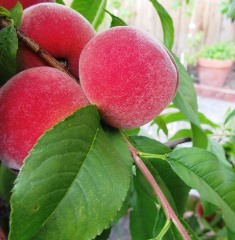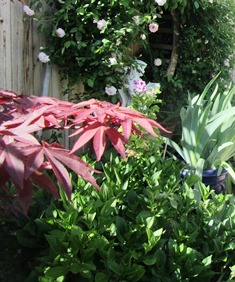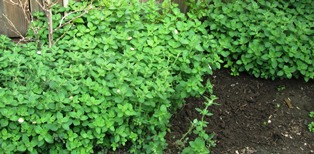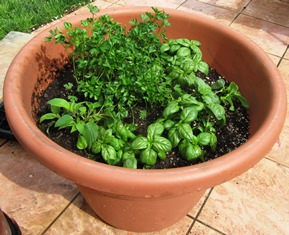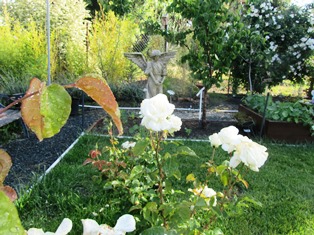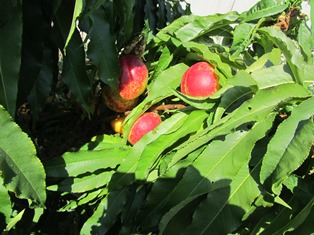Backyard Fruit Compote
Who feels like eating when the shorts and sandals weather has turned hot enough to warrant wearing bikini bottoms and thin cotton T-shirt for doing your household chores? Bring on the cool summer salads.
When the temperatures hit 105 on the farmette yesterday, we opted for a simple supper of cold chicken, orzo with Italian vinegar and oil dressing, and cold potato salad.
With nectarines and peaches ripening now on our trees, blueberries finally sweet enough to eat, and strawberries available at our local farmers’ market, what could be better for a dessert on a hot summer’s evening than a fruit compote.
Recipe for Backyard Fruit Compote
Gather the fruit, including nectarines, peaches, plums, strawberries, blueberries, kiwi, and melon.
Wash, and slice the nectarines, peaches, plums, and strawberries.
If including melon in the compote, scoop the melon into ball shapes using a melon baller or cut pieces of melon into cubes.
Peel and slice the kiwi.
Toss all into a bowl, adding the blueberries.
Sprinkle lightly with a scented sugar, or a super fine sugar, or honey.
Or, make a dressing: mix together 1/4 cup of lime juice, 1/4 cup of honey, 1 teaspoon of orange zest, 1 teaspoon of lime zest, and 1/2 teaspoon finely grated ginger. Pour over the fruit. Chill for about 1 hour and add springs of mint before serving.
Telltale Signs of Spring
As I write this, the honeybees are scouting every plant on the property. Awakened by warm weather and sunlight, they search for nectar. Aside from a few California poppies and other wildflowers blooming in front of the house, they won’t find much to forage on just yet.
Of course, there are a few apricot, nectarine, and almond tree blossoms as well as a smattering of white strawberry blooms in the raised beds at the back of our property. But within a few weeks, the warm weather of March and April will render the farmette virtually covered in masses of sweet offerings for the honeybees.
Still, there are the early signs of spring. The Japanese maples are leafing out in a dazzling show of red color. The pregnant stems of our bearded iris are swelling now for their Easter bloom cycle. And the Greek oregano is popping up everywhere as it does this time of year.
Birds are building nests, but I haven’t seen the red-breasted robins just yet. When they show up, searching for worms and grubs, I will know spring has truly arrived. Until then, I look for the telltale signs that Mother Nature is about to robe herself in the splendid garments of spring–fruit tree blossoms, leaves, blooming wildflowers, and lovely kitchen herbs pushing up all over the place.
Fall Spraying for Peach Leaf Curl
Just beyond the sliding glass door of my kitchen, we’ve carved a bit of a lawn and garden out of a wild weedy field. When I’m washing dishes or making jam, I can see my garden sanctuary where I’ve moved in a statue of an angel and positioned a bench near two nectarine trees–a perfect place to sit and take in the view of Mount Diablo’s peaks.
Of late, though the nectarine trees look less than healthy. The two heavy-bearers have become infected with the fungus that causes peach leaf curl. It’s not just my trees that are infected; two of my neighbors have the same problem. And this showed up late in my trees this year.
I’ve tried plucking off the twisted and contorted leaves as they show, discarding them in the garbage (not the compost pile). However, I fear I am losing this battle. The trees are going through a leaf drop now that it’s middle of November. I don’t want that fungus overwintering in the infected leaves, so I’m gathering those into the garbage, too. And I’ll begin a spraying program.
The nectarines and peaches need to be sprayed three or four times (if we have a strong rainy season), from autumn to bud break in the spring. Both lime sulfur and copper sprays can be used; both are considered organic, although some formulations are not very strong. But the leaves must not remain on the ground under the trees.
Last year, I sprayed those trees the required number of times with an organic horticultural oil recommended by the local garden center. The trees were fine most of the summer. But last month, the infection showed up. And here I am now, plucking the leaves from the trees and picking them up from the ground.
I dare not use anything on treating the fungus that is not organic and safe for the honeybees. Come spring, perhaps I’ll be rewarded for my vigilance with new growth that is healthy and free of the fungus.
 Facebook
Facebook Goodreads
Goodreads LinkedIn
LinkedIn Meera Lester
Meera Lester Twitter
Twitter






